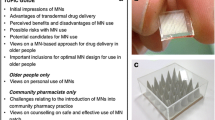ABSTRACT
Purpose
The objective of this study was to optimize a reproducible impedance spectroscopy method in elderly subjects as a means to evaluate the effects of microneedles on aging skin.
Methods
Human volunteers were treated with microneedles at six sites on the upper arm. Repeated impedance measurements were taken pre- and post-microneedle insertion. Two electrode types were evaluated (dry vs. gel), using either light or direct pressure to maintain contact between the electrode and skin surface. Transepidermal water loss (TEWL) was measured as a complementary technique.
Results
Five control subjects and nine elderly subjects completed the study. Microneedle insertion produced a significant decrease in impedance from baseline in all subjects (p < 0.05, regardless of electrode type or pressure application), confirming micropore formation. This was supported by a complementary significant increase in TEWL (p < 0.05). The gel*direct condition produced the lowest variability between measurements, as demonstrated by a coefficient of variation of 3.8% and 3.5% (control and elderly subjects, respectively). This was lower than variation between TEWL measurements at the same sites: 19.8% and 21.6% (control and elderly subjects, respectively).
Conclusions
Impedance spectroscopy reproducibly measures micropore formation in elderly subjects, which will be essential for future studies describing microneedle-assisted transdermal delivery in aging populations.


Similar content being viewed by others
Abbreviations
- (CV%):
-
Coefficient of variation
- (MN):
-
Microneedle
- (SC):
-
Stratum corneum
- (TEWL):
-
Transepidermal water loss
REFERENCES
Kim YC, Park JH, Prausnitz MR. Microneedles for drug and vaccine delivery. Adv Drug Deliv Rev. 2012;64(14):1547–68.
Wermeling DP et al. Microneedles permit transdermal delivery of a skin-impermeant medication to humans. Proc Natl Acad Sci U S A. 2008;105(6):2058–63.
Arora A, Prausnitz MR, Mitragotri S. Micro-scale devices for transdermal drug delivery. Int J Pharm. 2008;364(2):227–36.
Martanto W et al. Transdermal delivery of insulin using microneedles in vivo. Pharm Res. 2004;21(6):947–52.
Pergolizzi J et al. Opioids and the management of chronic severe pain in the elderly: consensus statement of an International Expert Panel with focus on the six clinically most often used World Health Organization Step III opioids (buprenorphine, fentanyl, hydromorphone, methadone, morphine, oxycodone). Pain Pract. 2008;8(4):287–313.
Squier CA, et al. The effect of aging in oral mucosa and skin. 1994: CRC Press.
Neerken S et al. Characterization of age-related effects in human skin: a comparative study that applies confocal laser scanning microscopy and optical coherence tomography. J Biomed Opt. 2004;9(2):274–81.
Curdy C et al. Non-invasive assessment of the effect of formulation excipients on stratum corneum barrier function in vivo. Int J Pharm. 2004;271(1–2):251–6.
Kalia YN, Guy RH. The electrical characteristics of human skin in-vivo. Pharm Res. 1995;12(11):1605–13.
Kawai E et al. Skin surface electric potential as an indicator of skin condition: a new, non-invasive method to evaluate epidermal condition. Exp Dermatol. 2008;17(8):688–92.
Gupta J et al. Kinetics of skin resealing after insertion of microneedles in human subjects. J Control Release. 2011;154(2):148–55.
Brogden NK et al. Development of in vivo impedance spectroscopy techniques for measurement of micropore formation following microneedle insertion. J Pharm Sci. 2013;102(6):1948–56.
Yamamoto T, Yamamoto Y. Electrical properties of the epidermal stratum corneum. Med Biol Eng. 1976;14(2):151–8.
Karande P, Jain A, Mitragotri S. Relationships between skin’s electrical impedance and permeability in the presence of chemical enhancers. J Control Release. 2006;110(2):307–13.
Lackermeier AH et al. In vivo ac impedance spectroscopy of human skin. Theory and problems in monitoring of passive percutaneous drug delivery. Ann N Y Acad Sci. 1999;873:197–213.
Brogden NK et al. Diclofenac delays micropore closure following microneedle treatment in human subjects. J Control Release. 2012;163(2):220–9.
Brogden NK et al. Diclofenac enables unprecedented week-long microneedle-enhanced delivery of a skin impermeable medication in humans. Pharm Res. 2013;30(8):1947–55.
Atkinson TJ et al. Medication pain management in the elderly: unique and underutilized analgesic treatment options. Clin Ther. 2013;35(11):1669–89.
Kaestli LZ et al. Use of transdermal drug formulations in the elderly. Drugs Aging. 2008;25(4):269–80.
Moxey ED et al. Prescription drug use in the elderly: a descriptive analysis. Health Care Financ Rev. 2003;24(4):127–41.
Norman JJ et al. Microneedle patches: usability and acceptability for self-vaccination against influenza. Vaccine. 2014;32(16):1856–62.
Donnelly RF, et al. Hydrogel-forming microneedle arrays can be effectively inserted in skin by self-application: A pilot study centred on pharmacist intervention and a patient information leaflet. Pharm Res, 2014.
Hoesly FJ et al. Safety of a novel microneedle device applied to facial skin: a subject- and rater-blinded, sham-controlled, randomized trial. Arch Dermatol. 2012;148(6):711–7.
Daddona PE et al. Parathyroid hormone (1–34)-coated microneedle patch system: clinical pharmacokinetics and pharmacodynamics for treatment of osteoporosis. Pharm Res. 2011;28(1):159–65.
Brogden NK. Clinical evaluation of novel methods for extending microneedle pore lifetime. PhD Dissertation, University of Kentucky. (2012).
Gosain A, DiPietro LA. Aging and wound healing. World J Surg. 2004;28(3):321–6.
Donnelly RF et al. Optical coherence tomography is a valuable tool in the study of the effects of microneedle geometry on skin penetration characteristics and in-skin dissolution. J Control Release. 2010;147(3):333–41.
Coulman SA et al. In vivo, in situ imaging of microneedle insertion into the skin of human volunteers using optical coherence tomography. Pharm Res. 2011;28(1):66–81.
ACKNOWLEDGMENTS AND DISCLOSURE
We would like to thank Mark Prausnitz and Vladimir Zarnitsyn for their assistance with designing the MN arrays. This work was funded by the American Association of Colleges of Pharmacy (AACP) New Investigator Award, and the Executive Council for Graduate and Professional Studies Student Research Grant (University of Iowa).
Author information
Authors and Affiliations
Corresponding author
Rights and permissions
About this article
Cite this article
Kelchen, M.N., Holdren, G.O., Farley, M.J. et al. Optimization of Impedance Spectroscopy Techniques for Measuring Cutaneous Micropore Formation after Microneedle Treatment in an Elderly Population. Pharm Res 31, 3478–3486 (2014). https://doi.org/10.1007/s11095-014-1435-y
Received:
Accepted:
Published:
Issue Date:
DOI: https://doi.org/10.1007/s11095-014-1435-y




